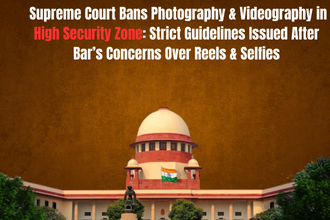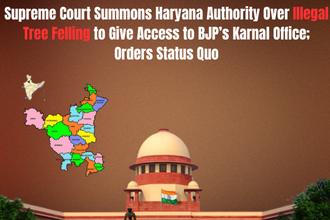In a significant move to preserve the dignity, security, and decorum of the highest judicial institution of the country, the Supreme Court of India has banned photography and videography inside its High Security Zone. The circular, issued by the Secretary General of the Supreme Court on September 12, 2025, lays down strict prohibitions with immediate effect.
The decision comes in the wake of increasing concerns expressed by the Supreme Court Advocates-on-Record Association (SCAORA) and the Supreme Court Bar Association (SCBA) regarding the growing trend of lawyers, interns, and even social media influencers creating reels, selfies, and video content inside the Supreme Court premises.
Why Did the Supreme Court Impose the Ban?
The move was triggered by repeated complaints from bar associations about advocates and visitors engaging in inappropriate photography and videography within the premises. Instances of “reel-making” for social media platforms had started becoming common, raising serious concerns about the dignity and sanctity of the Court.
Both SCAORA and SCBA highlighted how such practices compromise the solemnity of court proceedings, disturb the functioning of advocates, and also pose security threats. Responding to these representations, the Supreme Court took immediate action to curb the misuse of cameras and mobile phones.
Key Guidelines Issued by the Supreme Court
The circular introduces clear restrictions on the use of cameras, phones, and videography equipment inside the High Security Zone (HSZ). The highlights include:
- Complete Ban on Photography & Videography
- No photography or videography is permitted inside the High Security Zone, except for official purposes.
- Designated Media Zone
- Media personnel can conduct interviews and live broadcasts only at the designated media lawn in the Low Security Zone.
- Restriction on Mobile Phone Use
- Mobile phones cannot be used for photography or videography inside the High Security Zone lawns.
- Ban on Equipment
- Cameras, tripods, selfie sticks, and other devices used for reel-making or videography are prohibited inside the High Security Zone.
- Action Against Advocates, Interns & Law Clerks
- Any advocate, litigant, intern, or law clerk found violating the rules will face action from the concerned Bar Association or State Bar Council.
- Action Against Media Personnel
- If a media professional violates the guidelines, their access to the High Security Zone will be suspended for one month.
- Registry Staff & Other Stakeholders
- Violations by Registry staff will be dealt with seriously, and other stakeholders will face disciplinary action from their respective heads of departments.
- Security Personnel’s Authority
- Security officers have been given the right to stop any individual from taking photographs or videos in the High Security Zone.
Balancing Security and Media Freedom
While the restrictions may appear stringent, the circular makes an important distinction between regulated media coverage and casual videography. Journalists and accredited media personnel are still permitted to cover Supreme Court developments, but only from designated spaces.
This ensures that the freedom of press is not hampered while also maintaining the security and sanctity of the court premises.
Why Is This Move Important?
The Supreme Court is not just a place of justice; it is also a symbol of constitutional authority. Allowing casual photography, reels, and social media content creation within its High Security Zone would risk:
- Dilution of dignity of the institution.
- Disruption of judicial work and functioning of advocates.
- Security risks due to unregulated photography in sensitive zones.
- Misrepresentation on social media, where reels or videos could be taken out of context.
With the rise of digital content creation, several advocates and interns had started using the iconic Supreme Court backdrop for Instagram reels and vlogs. While such content may attract attention online, it undermines the *solemn atmosphere expected within court premises.
Bar Associations’ Role in Prompting the Ban
The issue gained urgency when SCAORA wrote to Chief Justice of India (CJI) highlighting the increasing instances of photography and videography. The SCBA also passed a resolution, recommending strict action against those indulging in videography, reel-making, or selfie culture in the court premises.
Both associations emphasized that the court should be seen as a sacred space for justice delivery, not as a backdrop for personal branding or social media content.
Disciplinary Measures and Enforcement
The circular places the responsibility of enforcement on different stakeholders:
- Bar Councils and Bar Associations → Action against advocates, litigants, interns, and law clerks.
- Supreme Court Registry → Accountability of its staff members.
- Media Authorities → Access suspension for violators.
- Security Personnel → On-the-spot enforcement authority.
This multi-level approach ensures that the guidelines are not just symbolic, but are effectively implemented and monitored.
Social Media vs. Judicial Decorum
The rise of social media has blurred lines between personal content creation and professional spaces. The Supreme Court’s ban serves as a reminder that courts are not entertainment venues. While lawyers and law students may be active on platforms like Instagram, YouTube, and X (Twitter), their professional conduct within court premises must adhere to the highest standards of dignity.
The ruling may also influence other High Courts and lower courts to introduce similar restrictions, ensuring uniformity across the judicial system.
Conclusion
The Supreme Court’s ban on photography and videography inside its High Security Zone is a timely and necessary step to safeguard the institution’s dignity, security, and decorum. By laying down strict guidelines and disciplinary measures, the Court has drawn a clear boundary between regulated media reporting and casual social media content creation.
With the active support of bar associations and strict enforcement by security personnel, this move is expected to restore the seriousness of the judicial environment while still allowing structured media coverage.
As India’s highest court, the Supreme Court’s actions set a precedent for ensuring that the administration of justice remains free from distractions, distortions, and undue sensationalism.
Also Read
Supreme Court Questions Centre on Governors’ Inaction Over Bills: Presidential Reference Hearing



